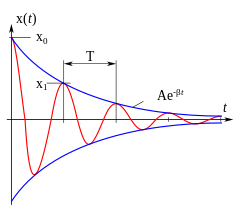Decay constant
 
|
| Representation of the time course of the variable with a free damped oscillation.
|
In linear oscillation systems with one degree of freedom, the decay constant is the product of the undamped natural angular frequency and Lehr's damping .
The time course of a linear oscillation can be given by the equation:
- , With
to be discribed. With a positive sign of the decay constant, the oscillation decays ; with a negative sign, the amplitude of the oscillation increases exponentially .
In the case of a damped oscillation ( ), the amplitude has decayed to less than 5% of the initial amplitude after approximately time .
In the case of measured step responses of any vibration system, the decay constant can be calculated approximately from the logarithmic decrement and the period of vibration .
The logarithmic decrement is calculated from two amplitudes that are separated by the period of oscillation. For linear systems, two amplitudes are sufficient. For weakly non-linear systems, several logarithmic decrements should be averaged. In the case of strongly non-linear systems, it is better to determine the time until the amplitude has entered a strip around ± 5 percent of the steady-state value.
Systems with PT1 behavior , e.g. B. the series connection of a spring and a damper are given by the differential equation
described. The time constant is the reciprocal of the decay constant.
See also
literature
- Hans Dresig , Franz Holzweißig : machine dynamics . 10th edition. Springer, Berlin 2011, ISBN 978-3-642-16009-7 , pp. 44 ( limited preview in Google Book search).
Individual evidence
- ^ Otto Föllinger : Control engineering . 6th improved edition. Hüthig Verlag 1985. ISBN 3-7785-1137-8













